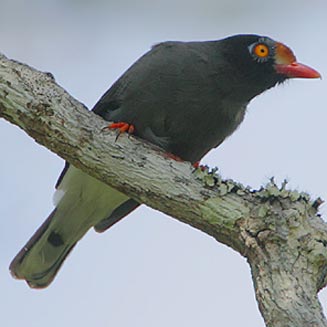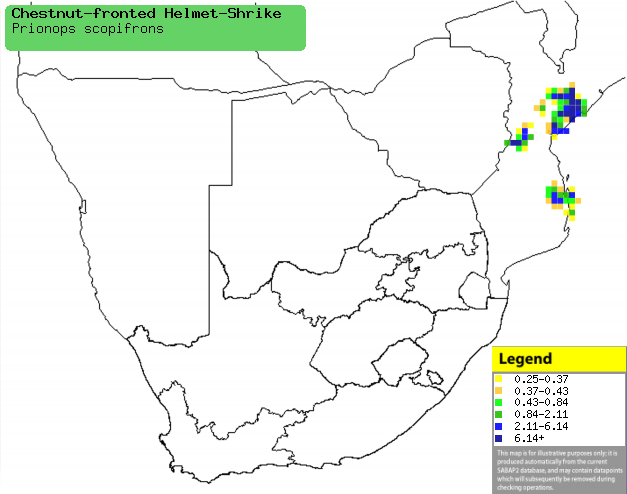|
Prionops scopifrons
(Chestnut-fronted helmet-shrike)
Stekelkophelmlaksman [Afrikaans]; Stekelkopklauwier
[Dutch]; Bagadais à front roux [French]; Braunstirnwürger [German];
Atacador-de-testa-castanha [Portuguese]
Life
> Eukaryotes >
Opisthokonta
> Metazoa (animals) >
Bilateria >
Deuterostomia > Chordata >
Craniata > Vertebrata (vertebrates) > Gnathostomata (jawed
vertebrates) > Teleostomi (teleost fish) > Osteichthyes (bony fish) > Class:
Sarcopterygii (lobe-finned
fish) > Stegocephalia (terrestrial
vertebrates) > Tetrapoda
(four-legged vertebrates) > Reptiliomorpha > Amniota >
Reptilia (reptiles) >
Romeriida > Diapsida > Archosauromorpha > Archosauria >
Dinosauria
(dinosaurs) > Saurischia > Theropoda (bipedal predatory dinosaurs) >
Coelurosauria > Maniraptora > Aves
(birds) > Order: Passeriformes
> Family: Malaconotidae
 |
|
|
Chestnut-fronted helmet-shrike, Arabuko-Sokoke
forest, Kenya. [photo Steve Garvie
©] |
|
Distribution and habitat
Occurs along Africa's eastern Coast, from Kenya to
Mozambique. Here it is generally uncommon, occupying lowland evergreen forest,
miombo (Brachystegia) woodland and tall riverine forest.
|
 |
|
Distribution of Chestnut-fronted helmet-shrike in southern Africa,
based on statistical smoothing of the records from first SA Bird Atlas
Project (©
Animal Demography unit, University of
Cape Town; smoothing by Birgit Erni and Francesca Little). Colours range
from dark blue (most common) through to yellow (least common). |
Food
Not much is known about its diet, other than it eats mainly
invertebrates, foraging mostly in the tree canopy gleaning insects from leaves
and branches. The following food items have been recorded in its diet:
Breeding
- The breeding habits of this species have not been well studied, but it is
known to be a cooperative breeder, with a number of helpers assisting the
breeding pair.
- The nest is a neat cup built of bark strips and grass cemented with
spider web, placed in the in a fork of horizontal branch in the tree canopy.
Usually all group members participate in the construction process.
- Egg-laying season is from about October-December.
- It lays about 3 eggs, which are incubated by group members, in shifts of
about 20-170 minutes.
- All the group members participate in the caring of the chicks, who still
roost in the nest after fledging.
Threats
Although it is not listed as threatened locally or
internationally, its numbers have been badly affected by fragmentation of
lowland evergreen forest.
References
-
Hockey PAR, Dean WRJ and Ryan PG 2005. Roberts
- Birds of southern Africa, VIIth ed. The Trustees of the John Voelcker
Bird Book Fund, Cape Town.
|
